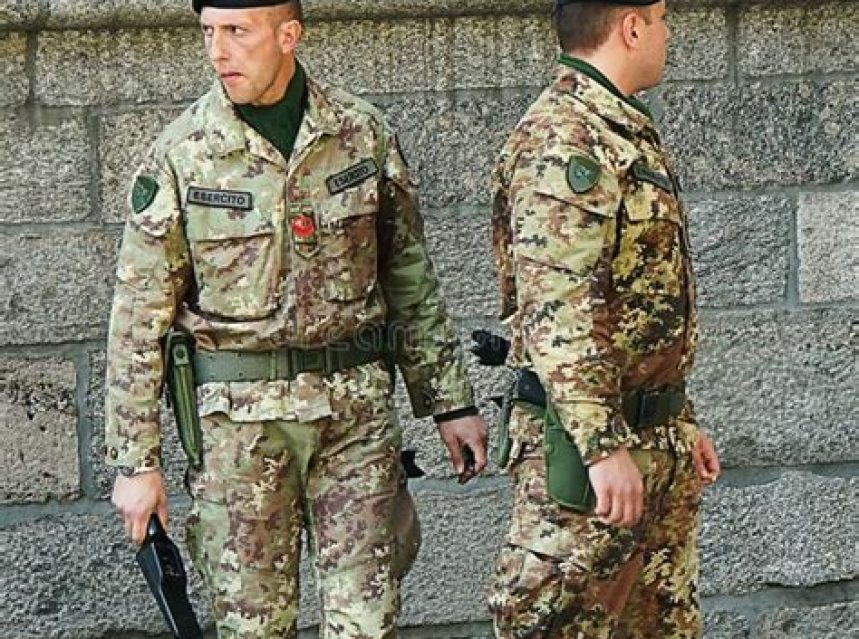Italy Military Uniform

Italian military uniforms have a rich history that spans centuries, from the ancient Roman legions to the modern military forces of Italy. Through this evolution, these uniforms not only served a practical purpose but also encapsulated cultural and symbolic meanings. In this blog post, we will explore the fascinating journey of Italian military uniforms, delving into their transformation during World War II and the symbolism embedded within them. Furthermore, we will examine how Italian fashion has influenced military attire and shed light on the contemporary designs of modern Italian military uniforms.
Evolution of Italian Military Uniforms
Italian military uniforms have changed dramatically over the centuries, reflecting not only the evolution of warfare but also the political and cultural influences of the time. From the medieval era to the modern day, the uniforms worn by Italian soldiers have undergone significant transformations in terms of style, design, and functionality. Let’s delve into the fascinating evolution of Italian military uniforms and explore the key milestones that have shaped their development.
One of the earliest forms of Italian military attire can be traced back to the Middle Ages, when Italy was divided into several city-states and feudal territories. During this period, soldiers wore a variety of garments that varied depending on their region of origin and social status. These uniforms were primarily designed to provide protection on the battlefield, with heavy armor, chainmail, and helmets being the norm. Soldiers often adorned their armor with colorful insignia and coats of arms, symbolizing their allegiance to a particular city or lord.
The Renaissance period witnessed a significant shift in Italian military uniforms. As the concept of chivalry gave way to more organized and professional armies, soldiers began to adopt more standardized attire. This included the iconic doublet, a fitted jacket that was typically worn over a shirt and breeches. The doublet would become a hallmark of Italian military fashion for centuries to come, with variations in style and decoration reflecting the prevailing trends of the time.
Fast forward to the 20th century, and Italian military uniforms underwent another major transformation during World War II. Italian soldiers were known for their distinctive olive-green uniforms, which incorporated elements such as cargo pockets, caps, and puttees. These uniforms not only provided functional benefits but also allowed soldiers to blend in with the natural surroundings, particularly in wooded or mountainous terrains. Despite the challenges faced by the Italian military during this period, their uniforms stood as a symbol of national identity and pride.
The evolution of Italian military uniforms also owes a great deal to the influence of Italian fashion. Italy has always been at the forefront of the global fashion industry, and this influence has extended to military attire as well. Throughout history, Italian designers have infused their creative flair into military uniforms, incorporating elements such as tailored cuts, luxurious fabrics, and stylish details. This fusion of fashion and functionality has resulted in modern Italian military uniforms that are not only practical but also exude a sense of elegance and sophistication.
In conclusion, the evolution of Italian military uniforms is a testament to the rich history and cultural heritage of Italy. From the medieval era to the present day, these uniforms have adapted to changing times, reflecting the progression of warfare, the influence of fashion, and the spirit of national pride. Whether it is the medieval suits of armor or the modern-day camouflage, Italian military uniforms continue to captivate us with their unique blend of style and purpose.
Italian Military Uniforms during World War II
The Italian military uniforms during World War II were a reflection of the country’s political and social landscape at that time. Italy, under fascist dictator Benito Mussolini, was aligned with Nazi Germany and Japan as part of the Axis powers. The uniforms worn by Italian soldiers during this period were designed to convey a sense of authority, power, and allegiance to the fascist regime.
One of the distinct features of the Italian military uniforms during World War II was the color scheme. The standard uniform for the Italian Army, known as the “Modello 1933”, was predominantly olive green in color. This color was chosen to blend with the natural environment and provide camouflage for soldiers in combat situations.
In addition to the color, the Italian military uniforms also featured various insignia and symbols. These symbols were used to depict rank, division, and membership in different military units. For example, the collar tabs of the uniforms were adorned with different designs to indicate the soldier’s rank. The sleeve patches displayed the unit and division to which the soldier belonged, allowing for easy identification on the battlefield.
Furthermore, Italian military uniforms during World War II also incorporated functional elements to provide practicality to the soldiers. Pockets were strategically placed to provide storage for essential items, and the design of the uniform allowed for ease of movement. The uniforms were tailored to fit the outdoor conditions and the demands of combat, ensuring that soldiers could carry out their duties effectively.
It is important to note that Italian military uniforms during World War II were not just a utilitarian aspect of the soldiers’ attire but also served as symbols of national pride and allegiance. The uniforms were intended to evoke a sense of patriotism and dedication to the fascist regime. With their distinct colors, insignia, and functional design, these uniforms played a crucial role in shaping the image of the Italian military during this tumultuous period in history.
Symbolism in Italian Military Uniforms
The history of Italian military uniforms is rich with symbolism, as each element of the uniform was carefully chosen to represent various aspects of the nation’s identity and values. From the colors and patterns to the accessories and insignia, every detail had a significance that went beyond mere fashion. In this blog post, we will explore the symbolism behind Italian military uniforms and how it reflects the history and culture of Italy.
One of the most prominent symbols in Italian military uniforms is the tricolor, which consists of green, white, and red vertical stripes. This flag has been a symbol of Italian identity since the country’s unification in the 19th century. The use of the tricolor in military uniforms emphasizes the soldiers’ allegiance to their nation and their commitment to defending its values and sovereignty.
Another significant symbol in Italian military uniforms is the emblem of the House of Savoy, the royal family that ruled Italy until the country became a republic in 1946. The emblem, known as the Savoy knot, is a distinctive cross-like design that represents nobility, tradition, and unity. It is often embroidered or printed on the uniforms as a mark of honor and heritage.
- Bold colors: Italian military uniforms are known for their bold and vibrant colors, which are intended to evoke a sense of confidence, authority, and national pride. The use of these bold colors helps distinguish Italian soldiers from other military forces and creates a strong visual impact.
- Insignia and badges: Italian military uniforms feature a variety of insignia and badges that denote the soldier’s rank, unit, and achievements. These symbols not only serve a practical purpose by identifying and distinguishing soldiers but also carry a sense of pride, accomplishment, and professionalism.
- Traditional patterns: Some Italian military uniforms incorporate traditional patterns, such as the distinctive “bardatura” pattern used in the Carabinieri uniforms. This pattern, consisting of red stripes on a dark blue background, is a symbol of the Carabinieri’s historical role as mounted soldiers and represents their connection to the Italian cavalry tradition.
| Symbol | Meaning |
|---|---|
| Tricolor | Symbol of Italian identity and national unity |
| Savoy knot | Represents nobility, tradition, and unity |
| Bold colors | Evoke confidence, authority, and national pride |
| Insignia and badges | Identify rank, unit, and achievements |
| Traditional patterns | Symbolize historical roles and traditions |
The symbolism in Italian military uniforms is not just a matter of aesthetics. It is a reflection of the nation’s history, values, and cultural heritage. Each element of the uniform tells a story, conveying messages of pride, loyalty, and unity. By understanding the symbolism behind these uniforms, we gain a deeper appreciation for the role of the military in Italian society and the importance of preserving and honoring these traditions.
Modern Italian Military Uniforms
Italy has a long and rich history when it comes to military uniforms. From the regal designs of the Renaissance to the practicality of World War II, Italian military uniforms have always been admired for their style and functionality. In recent years, however, there has been a shift towards modernization and contemporary design in Italian military attire. This blog post will delve into the evolution of modern Italian military uniforms and explore the significance of this shift in style.
One of the key features of modern Italian military uniforms is their emphasis on comfort and practicality. Gone are the days of stiff fabrics and restrictive designs. Instead, modern uniforms are made with lightweight and breathable materials that allow for ease of movement and adaptability. This is especially important in today’s fast-paced military operations, where agility and mobility are crucial.
In addition to their functionality, modern Italian military uniforms also embrace a sleek and minimalist aesthetic. The focus is on clean lines, simple silhouettes, and neutral colors such as black, grey, and olive green. This understated approach not only enhances the professionalism and discipline of the military personnel but also aligns with the contemporary fashion trends.
Another notable aspect of modern Italian military uniforms is the integration of advanced technologies. From moisture-wicking fabrics to temperature-regulating layers, these uniforms are designed to enhance performance and provide optimal comfort in various climates and environments. Additionally, the incorporation of modern tactical gear and accessories further enhances the functionality and effectiveness of Italian military personnel in the field.
In conclusion, modern Italian military uniforms represent a departure from the ornate and traditional designs of the past. With an emphasis on comfort, practicality, and contemporary aesthetics, these uniforms exude professionalism and adaptability. The incorporation of advanced technologies further underscores the commitment of the Italian military to stay at the forefront of innovation. As we move further into the 21st century, it will be interesting to see how Italian military uniforms continue to evolve and embrace the changing needs and trends of the modern world.
Influence of Italian Fashion on Military Attire
Italian fashion has long been renowned for its elegance, sophistication, and innovation. It comes as no surprise then, that Italian fashion has had a significant influence on military attire throughout history. From the evolution of Italian military uniforms to their symbolism and their role in World War II, the impact of Italian fashion on military attire is undeniable. In this blog post, we will explore the profound influence of Italian fashion on modern military uniforms and examine how Italian style has shaped military attire over the years.
One of the most striking aspects of Italian military uniforms is their impeccable tailoring and attention to detail. Italian fashion designers have always been known for their craftsmanship, and this meticulous approach to design has certainly made its way into military attire. The clean lines, well-fitted silhouettes, and carefully chosen fabrics all contribute to the overall sophistication of Italian military uniforms.
Another way in which Italian fashion has influenced military attire is through the use of symbolism. Italian military uniforms often feature intricate embroidery, distinctive colors, and unique insignia that reflect the country’s rich history and cultural heritage. These symbols not only serve to identify soldiers but also to convey a sense of pride, honor, and unity.
- The evolution of Italian military uniforms
- Italian military uniforms during World War II
- Symbolism in Italian military uniforms
- Modern Italian military uniforms
| Title | Description |
|---|---|
| Evolution of Italian Military Uniforms | Explore the historical development of Italian military uniforms. |
| Italian Military Uniforms during World War II | Learn about the role and significance of Italian military uniforms during World War II. |
| Symbolism in Italian Military Uniforms | Discover the meaning behind the various symbols and designs found in Italian military uniforms. |
| Modern Italian Military Uniforms | Examine the contemporary trends and innovations in Italian military attire. |
Frequently Asked Questions
What was the evolution of Italian military uniforms?
Italian military uniforms evolved over time, reflecting changes in technology, tactics, and societal norms. In the 19th century, uniforms featured elements inspired by French and Austrian designs. During the late 19th and early 20th centuries, the uniforms became more standardized, with a distinctive gray-green color becoming prevalent. In the 1930s, fascist influences brought changes to the uniforms, including blackshirts and specific insignia.
What did Italian military uniforms look like during World War II?
During World War II, Italian military uniforms underwent significant changes. The standard army uniform consisted of a khaki-green shirt, trousers, boots, and a distinctive M33 helmet. Fascist symbols, such as the fasces, were prominently featured on the uniforms and insignia.
What was the symbolism in Italian military uniforms during World War II?
Italian military uniforms during World War II were heavily symbolic, reflecting the fascist ideology that was prevalent at the time. The fasces, a bundle of rods symbolizing power and authority, was an important emblem displayed on uniforms, along with other fascist symbols like the Savoy knot. These symbols aimed to convey a sense of national unity and loyalty to the fascist regime.
How do modern Italian military uniforms look?
Modern Italian military uniforms have evolved to meet the demands of contemporary warfare and reflect the country’s role as a member of NATO. Camouflage patterns are now widely used, and the uniforms are designed for enhanced functionality and comfort. The colors have also changed, with a shift towards a more traditional dark green hue, often referred to as “vegetata” or “foliage.”
Has Italian fashion influenced military attire?
Yes, Italian fashion has had a significant influence on military attire. Italian designers have been known for their innovation and style, and this has been reflected in the design of military uniforms. Italy’s reputation as a fashion powerhouse has translated into well-tailored and aesthetically pleasing military attire that combines functionality with a touch of elegance.
What impact did Italian fashion have on the evolution of military uniforms?
Italian fashion played a role in transforming military uniforms from purely utilitarian garments to stylish and visually striking ensembles. Designers introduced sleeker silhouettes, finer fabrics, and attention to detail in military uniform design. This emphasis on aesthetics not only boosted morale among soldiers but also enhanced the overall image of the military.
How have Italian military uniforms influenced civilian fashion?
Italian military uniforms have had a lasting impact on civilian fashion. Elements such as epaulettes, brass buttons, and double-breasted coats are examples of military-inspired fashion that have become popular in the civilian world. Additionally, the emphasis on quality construction and attention to detail in military uniforms has influenced the standards of craftsmanship and tailoring in Italian civilian fashion.



